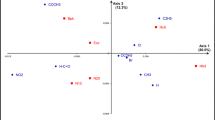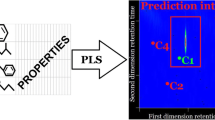Abstract
Based on the identical group as a pseudo atom instead of a typical atom, a novel modified molecular distanceedge (MDE) vector was developed in our laboratory to characterize chemical structure of polychlorinated dibenzofurans (PCDFs) congeners and/or isomers. Quantitative structure-retention relationships (QSRRs) between the new VMDE parameters and gas Chromatographic (GC) retention behavior of PCDFs were then generated by multiple linear regression (MLR) method for non-polar, moderately polar, and polar stationary phases. Four excellent models with high correlation coefficients, R=0.984-0.995, were proposed for non-polar columns (DB-5, SE-54, OV-101). For the moderately polar columns (OV-1701), the correlation coefficient of the developed good model is only 0.958. For the polar columns (SP-2300), the QSRR model is poor with R=0.884. Then cross validation with leave-one out of procedure (CV) is performed in high correlation with the non-polar (Rcv = 992-0.974) and weakly polar (Rcv=921) columns and in little correlation (Rcv=0.834) with the polar columns. These results show that the new vector is suitable for describing the retention behaviors of PCDFs on non-polar and moderately polar stationary phases and not for the various gas Chromatographie retention behaviors of PCDFs on the different polarity-varying stationary phases.
Similar content being viewed by others
References
Fletcher, C. L., McKay, W. A., Polychlorinated dibenzo-pdioxins PCDDs and debenzofurans PCDFs in the aquatic environment ~ a literature review, Chemosphere, 1993, 26: 1041–1069.
Hites, R. A., Environmental behavior of chlorinated dioxins and furans, Acc. Chem. Res., 1990, 23: 194–201.
Buchert, H., Ballschmiter, K., Polychlorodibenzofurans PCDF and -dioxins PCDD as part of the general pollution in environmental samples of urban areas, Chemosphere, 1986, 15: 1923–1926.
Karasek, F., Onuska, F., Trace analysis of the dioxins, Anal. Chem., 1982, 54:(309–317a).
Hollaway, T. T., Fairless, B. J., Freidline, C. E. {etetal.}, Performance of gas chromatographic-matrix isolation-Fourier transform infrared spectrometer, Appl. Spectrosc, 1988, 42: 359–368.
Kovats, E., Gas-chromatographische Charakterisierung organischer Verbindungen, Helvetica Chimica Acta, 1958, 41: 1915–1932.
Hale, M. D., Hileman, F. D., Mazer, T. {etetal.}, Mathematical modeling of temperature programmed capillary gas Chromatographic retention indexes for polychlorinated dibenzofurans, Anal. Chem., 1985, 57(3): 640–648.
Humppi, T., Heinola, K., Synthesis and gas chromatographic-mass spectroscopic determination of polychlorinated dibenzo-p-dioxins and related compounds in the technical chlorophenol formulation Ky-5, J. Chromtogr., 1985, 331(2): 410–418.
Kuroki, H., Haraguchi, K., Masuda, H., Synthesis of polychlorinated dibenzofuran isomers and their gas Chromatographic profiles, Chemosphere, 1984, 13(4): 561–573.
Fung, D., Boyd, R. K., Safe, S. {etetal.}, Gas chromatographic/mass spectrometric analysis of specific isomers of polychlorodibenzofurans, Biol. Mass Spectrom., 1985, 12(6): 247–253.
Mazer, T., Hileman, F. D., Noble, R. W. {etetal.}, Synthesis of the 38 tetrachlorodibenzofuran isomers and identification caplillary collumn gas chromatography mass spectrometry, Anal. Chem., 1983, 55(1): 104–110.
Donnelly, J. R., Munslow, W. D., Mitchum, R. K.{etet al.}, Correlation of structure with retention index for chlorinated dibenzo-P-dioxins, J. Chromatogr., 1987, 392: 51–63.
Kaliszan, R., Lamparczyk, H., A relationship between the connectivity indices and retention indices of polycyclic aromatic hydrocarbons, J. Chromatogr. Sci., 1978, 16(6): 246–248.
Zielins, W. L., Janini, G M., Utility of high-temperature thermotropic liquid crystals as stationary phases for novel gas-liquid Chromatographic separations, J. Chromatogr., 1979, 186: 237 -247.
Kang, J., Li, Z., On quantitative structure-retention relationship (QSRR) studies for predicting the gas chromatography retention indices of polycyclictic hydrocarbons (PAHs): quasi-length of carbon chain and pseudo-conjugated surface, J. Chromatogr., 1998, 682:361–367.
Budzinski, H., Radke, M., Garrigues, P. {etet al.}, Gas Chromatographic retention behavior of alkylated phenanthrenes on a smectic liguid crystalline phase.Apllication to organic geochemistry, J. Chromatogr., 1992, 627: 227–229.
Olsson, M., Sander, L. C., Wise, S. A., Comparison of liquid Chro matographic selective for polycyclic aromatic hydrocarbons on cyclodextrin and C18 bonded phases, J. Chromatogr., 1989, 477: 277–290.
Needham, M. D., Jurs, P. C., Quantitative structure-retention relationship studies of polychlorinated dibenzodioxins on gas Chromatographic stationary phases of varying polarity, Anal. Chim. Acta, 1992, 258: 183–198.
Needham, M. D., Jurs, P. C., Quantitative structure-retention relationship studies of polychlorinated dibenzofurans on gas Chromatographic stationary phases of varying polarity, Anal. Chim. Acta, 1992, 258: 199–218.
Liang, X., Wang, W., Wu, W. {etet al.}, Prediction of the retentions of polybrominated dibenzo-p-dioxins (PBDDs) by using the retentions of polychlorinated dibenzo-p-dioxins (PCDDs), Chemosphere, 2000, 41(6): 917–921.
Liang, X., Wang, W., Wu, W. {etet al.}, Quantitative relationship between Chromatographic retentions and molecular structures of polychlorinated dibenzo-p-dioxins (PCDDs), Chemosphere, 2000, 41(6): 923–929.
Liu, S. S., Li, Z., Approach to estimation and prediction for normal boiling points of alkanes based on a molecular distance-edge vector (MDE), J. Chem. Inf. Comput. Sci., 1998, 38(3): 387–394.
Liu, S., Liu, H., Li, Z., Molecular distance-edge vector (μ): an extension from alkanes to alcohols, J. Chem. Inf. Comput. Sci., 1999, 39(6): 951–957.
Li, S. Z., Fu, B., Wang, Y. {etet al.}, On structural parameterization and molecular modeling of peptide analogues by molecular electronegativity edge vector (MEE): estimation and prediction for biological activity of dipeptides, J. Chin. Chem. Soc., 2001, 48(5): 937–944.
Liu, S., Yin, C., Li, Z., Molecular structural vector description and retention index of polycyclic aromatic hydrocarbons (PAHs), Chemom. Intell. Lab.Syst, 2002, 61: 3–15.
Liu, S., Liu, H., Li, Z., Molecular distance-edge vector (μ) and Chromatographic retention index of alkanes, J. Chin. Chem. Soc., 2000, 47(3): 455–460.
Author information
Authors and Affiliations
Corresponding author
About this article
Cite this article
Deng, H., Huang, P., Hu, Y. et al. A novel molecular distance edge vector as applied to chemical modeling of quantitative structure-retention relationships: Various gas Chromatographic retention behaviors of polychlorinated dibenzofurans on different polarityvarying stationary phases. Chin.Sci.Bull. 50, 1683–1687 (2005). https://doi.org/10.1360/982004-252
Received:
Accepted:
Issue Date:
DOI: https://doi.org/10.1360/982004-252




